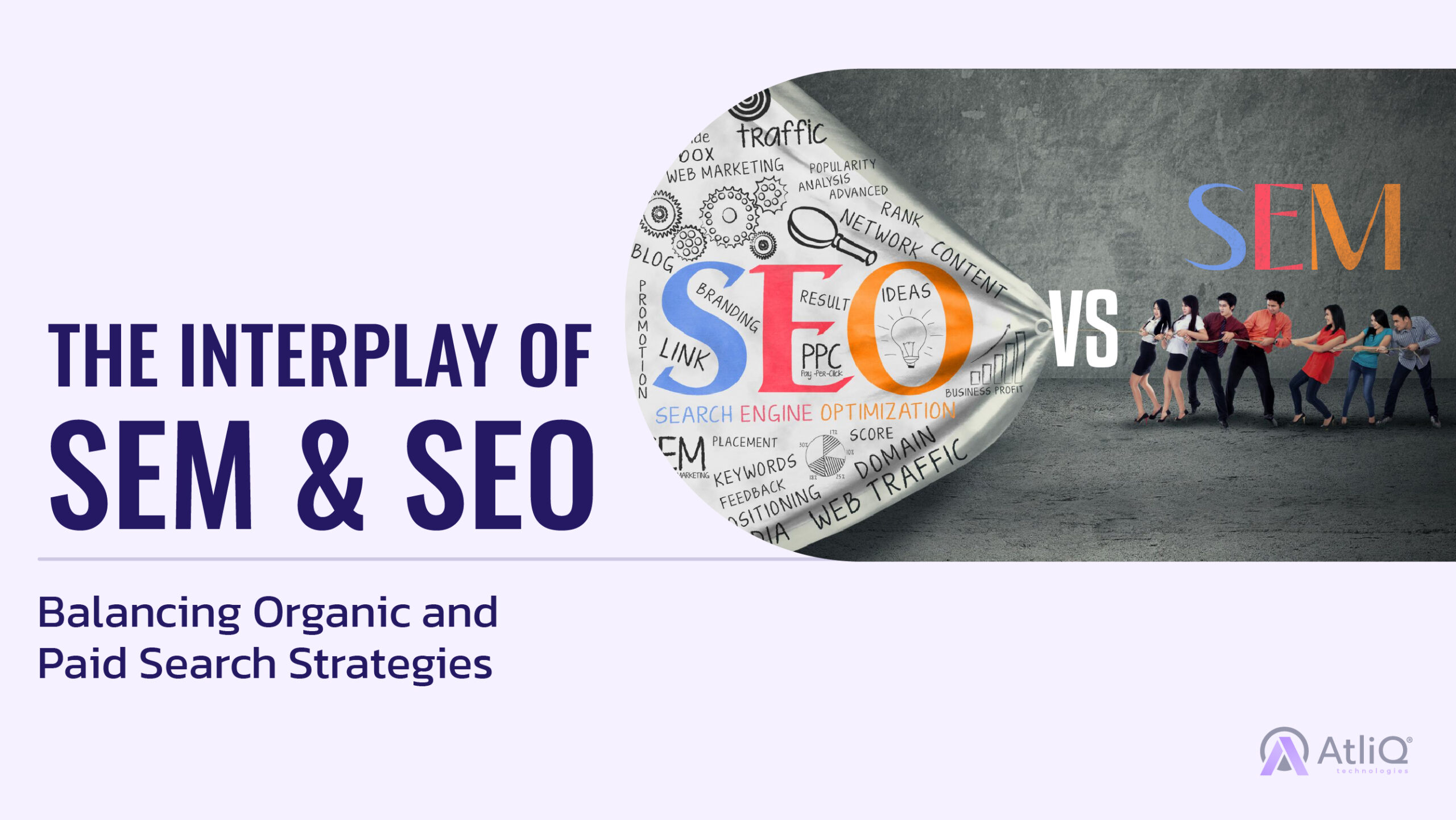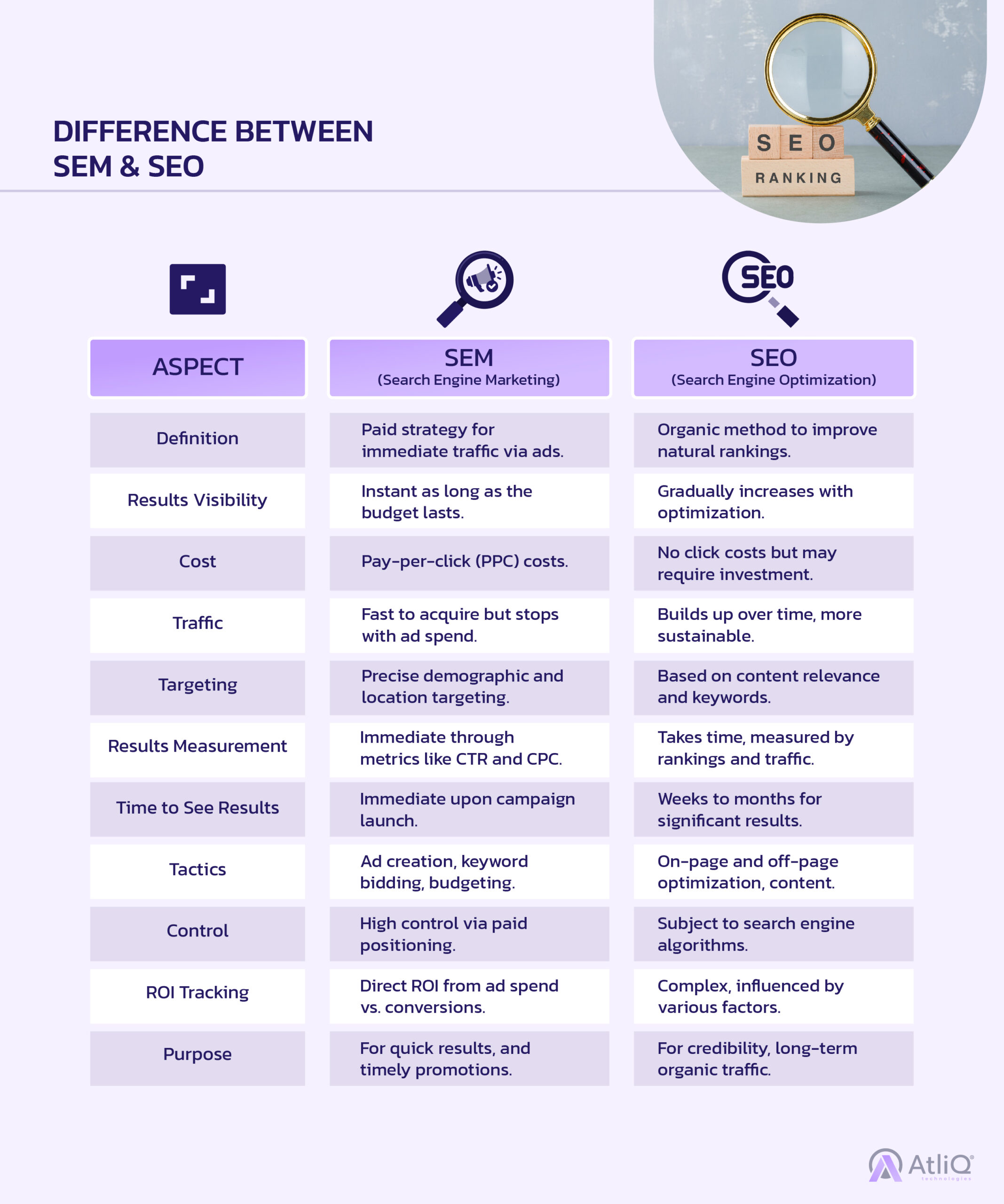
The Interplay of SEM and SEO: Balancing Organic and Paid Search Strategies
Welcome to the digital playing field where two giants — SEM and SEO — play a game of chess on the vast board of search engines. One moves with the speed of a sprinter, dashing towards quick wins with the power of paid ads, while the other strategizes like a marathon runner, building endurance through organic growth. It’s a game of finesse and savvy, a balance between swift action and deliberate pace.
As gatekeepers to visibility, these players shape the destiny of businesses large and small in the digital realm. But the game is changing, becoming more complex and intertwined. It’s not about picking a side; it’s about mastering the moves of both to achieve a victory not just for the moment, but for the long run.
Join us as we pull a chair to this fascinating game, where every move counts. Whether you’re a rookie to the digital world or a seasoned strategist, this blog is designed to captivate and guide you through the entwined paths of paid and organic search strategies.
Let the game begin!
What is SEM?
Search Engine Marketing, or SEM, is like buying a fast-pass ticket at an amusement park. It allows your website to jump ahead in line and get noticed quickly by people searching online. In SEM, you create ads that will show up on search engine results pages (SERPs) when someone types in certain keywords. It’s a powerful way to attract traffic to your site because you’re reaching people at the exact moment they are looking for what you have to offer. With SEM, you pay every time someone clicks on your ad—a model known as pay-per-click (PPC). It’s all about visibility and getting immediate results through paid advertising campaigns on search engines like Google or Bing.
What is SEO?
Search Engine Optimization, or SEO, is the process of grooming your website so that it naturally climbs higher in the rankings of search engine results. It’s the organic way to draw visitors, meaning you don’t pay for each click as you do with SEM. SEO involves fine-tuning your website’s content and structure, using relevant keywords that people might enter in search engines when looking for information, products, or services that match what you offer. It’s about making your site more attractive to search engines, so they show it as a top result for searches. This organic ranking is built over time through methods like optimizing web pages, building backlinks, and creating quality content useful for your audience.
Understanding SEM: Paid Search Strategies
Overview of Paid Search: Paid search is the secret weapon in your SEM arsenal, allowing for an on-demand increase in visibility on search engine results pages through advertising. With paid search, you essentially bid for ad space, and when potential customers search for terms related to your business, your ads appear prominently, often at the top or bottom of the results page. Because of this premium placement, paid search can drive immediate traffic to your website and deliver real-time results.
Key Components of a Successful SEM Campaign:
- Keyword Research & Selection: The bedrock of SEM is choosing the right keywords. These are the words and phrases potential customers type into search engines looking for what you offer. Ideal keywords align with your business, have a decent search volume, and aren’t too competitive — making your ads visible to your target audience at an affordable cost.
- Ad Copy and Creative: Craft ad copy that grabs attention and encourages clicks. Use clear language, highlight your unique selling points, and include a compelling call to action. Complement this with creative visuals that reflect your brand and catch the eye in the competitive ad space.
- Landing Page Optimization: Your ad’s landing page should fulfill the promise made by the ad. It needs to be on-topic, visually inviting, and easy to navigate. The goal is clear, be it capturing leads, closing sales, or providing information, ensuring visitors stick around.
- Bid Management & Budget Allocation: To get the most out of your SEM campaigns, manage your bids and budget smartly. Determine what you’re willing to pay per click and spread your budget effectively across campaigns. Keep a close eye on spending to maximize ROI.
- Analytics & Performance Monitoring: One of SEM’s advantages is its trackability. Use analytics to monitor ad success, focusing on metrics like click-through and conversion rates, cost per click, and quality score. Regular analysis lets you fine-tune campaigns for better performance over time.
When to Prioritize SEM in Your Strategy?
Ahh! The question of the hour! Prioritizing SEM is particularly effective when you’re looking to drive quick results, such as a time-sensitive promotion or event. It’s also valuable when launching a new business or product, entering a competitive market, or targeting high-intent customers who are ready to make a purchase. Essentially, when immediate visibility is critical, and you have the budget to invest, SEM should be a top priority in your overall digital marketing strategy.

Understanding SEO: Organic Search Strategies
Organic search refers to the natural rankings on search engine results pages that aren’t influenced by paid advertising. This is the heart of SEO, where the goal is to optimize your website so that search engines rank it higher for relevant searches. A strong organic presence is earned through quality content and SEO best practices, which help to establish credibility and trust with search engines over time.
Essential Elements of an Effective SEO Strategy:
- Keyword Research & Content Creation: A successful SEO strategy starts with keyword research, identifying the terms your target audience searches for. Once you know these, you can create valuable content that answers their questions, solves their problems, and includes those keywords naturally.
- On-page Optimization: On-page SEO involves optimizing individual web pages to rank higher and earn more relevant traffic. Key factors include using relevant keywords in your titles, headers, and throughout the page content, as well as optimizing meta descriptions and URL structures to be clear and search-friendly.
- Technical SEO: This facet of SEO deals with the non-content elements of your website. Improving technical aspects like site speed, mobile responsiveness, and structured data can make your site more attractive to search engines and users alike, contributing to better rankings.
- Off-page SEO: Your website’s authority is built largely through off-page SEO, which involves efforts outside of your site. Gaining backlinks from reputable sites, social media engagement, and other online mentions signal to search engines that others validate your content.
- Local SEO Considerations: For businesses serving specific geographic areas, local SEO is crucial. This includes managing your Google My Business listing, obtaining local citations, and ensuring your NAP (Name, Address, Phone Number) information is consistent across the web.
The Long-term Benefits of SEO
Investing in SEO is playing the long game, where the results compound over time. The benefits include sustained traffic growth, improved site usability, and a continuous return on investment as your site becomes more visible to users who are actively seeking what you offer. Unlike paid search strategies that stop when you stop paying, the effects of a well-executed SEO strategy can continue to drive traffic and leads for the long term, making it a cornerstone of your digital marketing efforts.
Best Practices for Combining SEM and SEO
- Aligning Campaigns Toward a Common Goal: When SEM and SEO work towards the same objectives, the impact of your overall search strategy is amplified. Set shared goals for both your organic and paid efforts, such as increasing overall traffic, generating leads, or boosting sales for specific products. By aligning your campaigns, you coordinate your tactics to push towards these unified targets more effectively.
- Consistent Messaging and Branding Across Organic and Paid Channels: Consistency is key to building trust and recognition with your audience. Ensure that your ad copy, keywords, and content reflect the same brand message and voice, whether a user encounters your site through paid ads or organic search results. This consistency helps reinforce your brand messaging, provides a seamless user experience, and strengthens your brand presence online.
- Leveraging Insights from SEM in SEO: SEM can serve as a testing ground for SEO strategies. For example, you can trial specific keywords in your paid campaigns to gauge performance and, if successful, integrate these terms into your SEO content strategy. By sharing learnings between SEM and SEO, you can make data-informed decisions to boost overall search performance.
- Ensuring Clear Tracking and Attribution Models for Accurate Measurement: Accurate tracking and attribution are crucial for understanding the success of your search strategies and how they complement each other. Implement robust analytics tools to measure the performance of both SEM and SEO initiatives, such as conversion rates, click-through rates, and keyword rankings. Use this data to adjust campaigns, allocate budgets wisely, and ensure both SEM and SEO are contributing to your overall marketing goals.
Future Trends: The Evolving Search Landscape
- Voice Search and Its Impact on SEM/SEO: As voice-activated devices become ubiquitous, voice search is significantly changing how people interact with search engines. With more conversational queries, both SEM and SEO need to adapt by focusing on long-tail keywords and natural language. This shift pushes marketers to consider the intent behind spoken queries and optimize content to fit this more personable approach.
- The Rise of Artificial Intelligence and Machine Learning: AI and machine learning are revolutionizing search by delivering more personalized experiences. SEM campaigns can now benefit from AI-driven automation for bidding and targeting, while SEO can leverage machine learning to deliver predictive insights on ranking factors. As search engines get smarter, strategies must evolve to stay ahead.
- Changes in Search Algorithms and User Behavior: Frequent updates to search algorithms require SEM and SEO to remain agile. These updates often aim to improve user experience, meaning both paid and organic strategies must focus on delivering valuable, user-centric content. As user behavior evolves, adapting to new browsing patterns and preferences is crucial.
- Predictions for the Future Interplay Between SEM and SEO: The connection between SEM and SEO is expected to deepen, with each feeding into the other’s success. We may see a more data-driven approach to how these strategies intertwine, with shared analytics providing a holistic view of search performance. As search continues to evolve, integrated strategies that account for both paid and organic will be key to capturing and engaging audiences across the search landscape.
Related:
Content Marketing
Effective Professional Web Design
Essential Page Load Time Statistics
While the landscape continues to shift with technological advancements and changing user behaviors, the underlying principle remains – a cohesive strategy that marries the prompt visibility of paid search with the enduring presence of organic optimization will pave the road to success.
To navigate these complex waters, and harness the full potential of both paid and organic search, it’s crucial to partner with a team that not only understands the current trends but can also anticipate and adapt to future changes.
Ready to optimize your SEM and SEO efforts and lead the charge in the digital domain? Contact AtliQ Technologies today, and let’s chart a course for your success. Together, we will create a winning strategy that not only adapts to the ever-changing search landscape but also thrives within it.